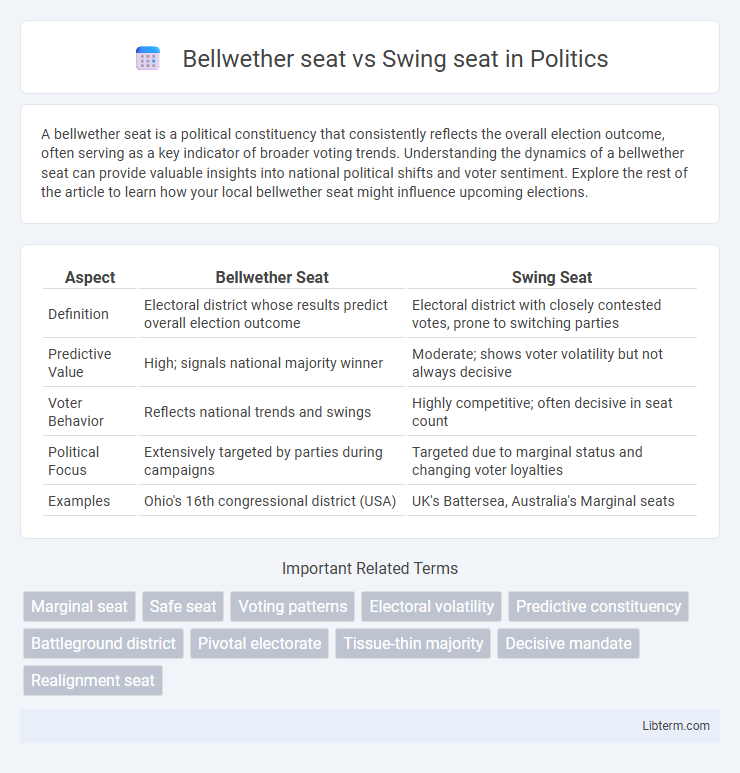A bellwether seat is a political constituency that consistently reflects the overall election outcome, often serving as a key indicator of broader voting trends. Understanding the dynamics of a bellwether seat can provide valuable insights into national political shifts and voter sentiment. Explore the rest of the article to learn how your local bellwether seat might influence upcoming elections.
Table of Comparison
| Aspect | Bellwether Seat | Swing Seat |
|---|---|---|
| Definition | Electoral district whose results predict overall election outcome | Electoral district with closely contested votes, prone to switching parties |
| Predictive Value | High; signals national majority winner | Moderate; shows voter volatility but not always decisive |
| Voter Behavior | Reflects national trends and swings | Highly competitive; often decisive in seat count |
| Political Focus | Extensively targeted by parties during campaigns | Targeted due to marginal status and changing voter loyalties |
| Examples | Ohio's 16th congressional district (USA) | UK's Battersea, Australia's Marginal seats |
Definition of Bellwether Seat
A Bellwether seat is a specific electoral district that historically reflects the overall outcome of an election, often indicating which party will form the government. These seats are closely watched because their voting patterns typically align with the national or regional political trend, making them reliable predictors of election results. Unlike swing seats, which are competitive and can change hands frequently, bellwether seats have a consistent record of mirroring the winning party, providing strategic insights for political campaigns.
Definition of Swing Seat
A swing seat refers to an electoral district or constituency that can reasonably be won by different political parties in an election, often fluctuating with changing voter preferences. These seats are highly contested due to their potential to tip the balance of power in legislative bodies. Unlike bellwether seats, which consistently predict the overall election winner, swing seats are defined by their unpredictability and competitive nature during elections.
Key Differences Between Bellwether and Swing Seats
Bellwether seats consistently predict overall election winners by mirroring broader voting trends, while swing seats are highly competitive constituencies that frequently change party control. Bellwether seats serve as reliable indicators of national political sentiment, often aligning with the prevailing electoral outcome. Swing seats, due to their unpredictable voter behavior, hold strategic importance for parties aiming to secure or shift legislative majorities.
Historical Examples of Bellwether Seats
Bellwether seats like Ohio's 12th congressional district have historically predicted national election outcomes, reflecting broader voter sentiment due to their demographic diversity. In Australia, the seat of Eden-Monaro served as a reliable bellwether from 1972 to 2013, aligning with every federal election result and signaling government formation. These examples illustrate how bellwether seats differ from swing seats by consistently mirroring overall electoral trends rather than merely fluctuating between parties.
Historical Examples of Swing Seats
Swing seats, known for their unpredictability in elections, often determine the overall outcome due to their fluctuating party support. Historical examples include Ohio in U.S. presidential elections, which frequently swings between parties and influences the final result significantly. Other notable swing seats like Florida and Pennsylvania have also played pivotal roles in shaping national leadership.
Importance of Bellwether Seats in Elections
Bellwether seats serve as critical indicators in elections by reflecting broader voter trends and predicting overall outcomes with high accuracy. These constituencies often mirror the political climate, making their results invaluable for parties strategizing campaigns and allocating resources efficiently. Swing seats, while competitive and crucial for gaining majorities, lack the consistent predictive reliability that bellwether seats provide in forecasting national election results.
Impact of Swing Seats on Electoral Outcomes
Swing seats, also known as marginal or battleground constituencies, critically influence electoral outcomes due to their unpredictable voter behavior and potential to shift party dominance. Unlike safe or bellwether seats, which usually reflect larger political trends or consistently favor a single party, swing seats can alter the balance of power in legislatures by determining the election result. Political campaigns intensely target these constituencies to sway undecided voters, making them key battlegrounds in closely contested elections.
Factors Influencing Bellwether vs Swing Status
Bellwether seats consistently align with the overall election outcome due to demographic stability and representative voter behavior, whereas swing seats exhibit fluctuating voter preferences driven by local issues, candidate appeal, and campaign intensity. Factors influencing bellwether status include homogeneous socio-economic profiles and historical voting patterns that mirror national trends, while swing seats are shaped by diverse electorates and shifting political landscapes. Electoral volatility, media influence, and strategic party targeting also play critical roles in distinguishing bellwether seats from swing seats.
Case Studies: Notable Bellwether and Swing Seats
Notable bellwether seats such as Ohio's 16th Congressional District have consistently mirrored national election outcomes, showcasing their predictive power in U.S. presidential races. Swing seats like Florida's 27th Congressional District demonstrate high variability, often switching party control between elections and influencing overall political balance. Case studies reveal bellwether seats tend to reflect broader demographic trends, while swing seats highlight localized electoral dynamics crucial for campaign strategies.
Predictive Value: Bellwether vs Swing Seats in Modern Politics
Bellwether seats serve as accurate predictors of overall election outcomes due to their consistent alignment with winning parties, reflecting broader voter sentiment across regions. Swing seats, while less consistently representative, are critical battlegrounds where shifts in voter preferences can signal emerging political trends or volatility within the electorate. Analyzing voting patterns in bellwether districts offers a clearer forecast of national results, whereas swing seat dynamics provide nuanced insights into localized political swings and candidate appeal.
Bellwether seat Infographic

 libterm.com
libterm.com